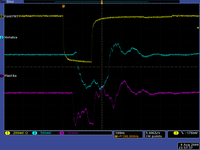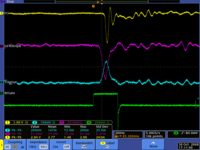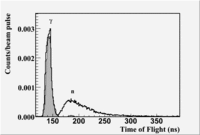TF NEUP 2011
Technical Work Scope Identifier: FC-3
submit proposal at
www.neup.gov/
which forwards you to
https://inlportal.inl.gov/portal/server.pt?open=512&objID=600&mode=2
Tittle: An evaluation of a fission chamber's temporal response using gas electron multiplication
Project Summary
This project seeks to improve the response of a fission chamber by transferring a technology known as Gas Electron Multiplication developed in the late 1990s for high energy physics detectors. A Gas Electron Multiplier functions as a preamplifier when immersed in the detector's gas. The response time of a fission chamber can be improved by reducing the detector's components in size because of the increased free charge produced by the preamplifier. This technology has demonstrated an improvement in an ionization chamber's response time by at least a factor of 3. The faster detector signal will extend the detectable neutron flux beyond the current signal pile up region. The increased signal amplification may also be used to improve the detector's ability to measure the location of the incident particle on the entrance to the detector. We propose to measure the improved performance of a fission chamber equipped with Gas Electron Multipliers and evaluate its use as a neutron tomography imaging device.
Importance and relevance of proposed work
We propose to investigate a neutron instrumentation upgrade by transferring an innovation developed for gaseous detectors in the late 1990s. The NEUP's 2012 request for pre-applications calls for Program Supporting and Mission Supporting R&D in Fuel Cycle Research and Development, Reactor Concepts Research, Development and Demonstration, and Nuclear Energy Advanced Modeling and Simulation. We believe the development of the above instrumentation is aligned with NEUP's Program Supporting and Mission Supporting R&D, in particular the Fuel cycle initiative. As described above, our proposal to equip fission chambers with this novel technology could enhance their neutron detection by decreasing the rise time of the devices signal by a factor of 3 An an added benefit of this investigation, the proposal can also addresses the April 2010 Roadmap report to congress that identified the "Obsolete analog instrumentation and control technologies" as one of the major challenges facing the current nuclear power plant fleet. An improvement of the neutron detection technology will not only assist the Fuel Cycle initiative by providing a detector to essentially perform neutron tomography, but it may also impact the ability to measure high neutron fluxes near the reactor core.
From the RFP
his research topic will also pursue advanced measurement techniques that could
complement the ongoing measurement program. In particular, fission multiplicity and fission neutron
spectrum measurements as a function of incident neutron energy have been identified as important data in
recent sensitivity analyses. Key university research needs for this activity include:
" New and improved detector systems and sensor materials that can be used to increase the
accuracy, reliability, and efficiency of nuclear materials quantification and tracking from the
perspective of the operator or state-level regulator. Such systems could include new neutron
coincidence/anti-coincidence counting, spectroscopic analysis, chemical, calorimetric, or other
non-nuclear methods, as well as any other novel methods with potential MC&A benefits;
Mission Supporting R&D is considered creative, innovative, and transformative (blue-sky), but
must also support the NE mission. Mission-supporting activities that could produce breakthroughs
in nuclear technology are also invited to this solicitation. This includes research in the fields or
disciplines of nuclear science and engineering that are relevant to NE’s mission though may not
fully align with the specific initiatives and programs identified in this solicitation. This includes,
but is not limited to, Nuclear Engineering, Nuclear Physics, Health Physics, Radiochemistry,
Nuclear Materials Science, or Nuclear Chemistry. Examples of topics of interest are new reactor
designs and technologies, advanced nuclear fuels and resource utilization, instrumentation and
control/human factors, radiochemistry, fundamental nuclear science, and quantification of
proliferation risk and creative solutions for the management of used nuclear fuel.
Program supporting research requested by this solicitation is detailed as discreet workscopes in
Appendix A. The information is organized by program area with each specified workscope
providing the basis for a stand-alone R&D pre-application submittal.
Fuel Cycle Research and Development
New and improved detector systems and sensor materials that can be used to increase the
accuracy, reliability, and efficiency of nuclear materials quantification and tracking from the
perspective of the operator or state-level regulator. Such systems could include new neutron
coincidence/anti-coincidence counting, spectroscopic analysis, chemical, calorimetric, or other
non-nuclear methods, as well as any other novel methods with potential MC&A benefits;
Logical pathway to work accomplishments
The pathway to develop a fission chamber equipped with Gas Electron Multipliers will consist of three broad steps. The first step will
focus on the construction of a fission chamber with gas electron multiplication pre-amplifiers. The PI of this proposal has produced several ionization chambers equipped with gas electron multipliers that are constructed from copper clad kapton foils. A comparison of the output signal from an ionization chamber with the gas electron multiplier pre-amplifier is shown in the figure below along with a typical signal from a drift chamber (geiger muller tube) detector. The duration of the output pulse is at least a factor of two longer for an ionization chamber which does not use gas electron multiplication. The output pulse of the gas electron multiplier equipped chamber is also more gaussian like. THis performance occurs because the ionization region within the detector can be reduced in size using the preamplifiers. The ionized particle in the chamber have a shorter drift distance and result in a faster output signal response. The objective in this proposal will be to add a fissionable material to an ionization chamber making it neutron sensitive.
The next logical step will be to test the proposed instrument response to neutrons. The figure below illustrates a neutral particle time of flight measurement using the High Rep Rate Linac facility that is managed by the Idaho Accelerator Center and located at Idaho State University's physics department. A Tungsten radiation was used in conjuction with a 15 MeV electron beam to create a photon source from Bremstrahlung radiation. The emmitted photons entered the experimental cell which held either a water or deuterated water (HDO) target. A NaI detector was positioned 2 meters away from the target and at the azimuthal angle of 90 degrees to detect neutral particles. The hatched peaks in the histrogram represent the NaI detector measurement when using a water target. The un-hatched histogram shows a clear neutron event enhancement when using the HDO target. We observed an integrated neutron rate of 50 Hz in the 2 cm x 2 cm NaI detector. We propose using this device to test the temporal performance of a gas electron multiplier equipped fission chamber.
Deliverables and outcomes
The project will construct a fission chamber equipped with gas electron multiplier pre-amplifiers. The temporal response of the fission chamber to fast neutrons will be quantified.
Timeline
This project spans a three year period. Year one will be devoted to machining the components of a fission chamber equipped with gas electron multipliers. Assembly of the detector with a fission target will be completed in year 2. In the final year, the device will be tested using neutrons generated by the bremstrahlung photons from electrons accelerated by a 16 MeV Linac that impinge on a target of deuterated water (HDO).
Budget
We request total of $290,000 for a period of three years to defray the costs of this Program Supporting development of an improved fission chamber. The main expense will be for a graduate student ($50k) and some faculty mentor time ($20k) per year. equipment construction and beam time expenses are also requested in the amount of $30k per year.
Neutron fluxes in reactors
according to http://www.bnl.gov/bnlweb/history/HFBR_main.asp
a 40 MW reactor at Brookhaven's High Flux Beam Reactor (HBFR) produced a neutron flux of for experiments. The neutron flux was a maximum outside the core because the neutrons were directed tangentially to the core instead of radially.
1e11 to 1e12 neutrons per cm^2 per second may be more typical
Let's assume this flux is an upper limit for a detector to measure neutron fluxes in a reactor core. The pulse width of a regular GEM detector is sec. Because of the high gain a signal may be observed over a surface area of 3 cm^2 (10 cm by 300 \times 10^{-3} cm ). A GEM detector with this active area would only be able to count neutron fluxes of if the detector efficiency was 100 %. A detector efficiency of 10^{-5} would be able to see rates of 10^{11}.
The pulse width of a standard ionization chamber is on the order of 300 nsec, so a standard GEm detector would only be able to have a factor of 6 higher rate than a typical ionization/fission chamber.
Deliverables and outcomes
1.) Neutron sensitive ionization chamber (no position readout)
Bibliography
- File:NEUP Pre-app RFP.pdf
- "Fission chambers for CANDU SDS neutronic trip applications", V. Mohindrs, M. Vartolomei, and A. McDonald, 28th Annual Canadian Nuclear Society (CNS) conference, June 3-6, 2007New Brunswick, Canada Media:Virender_CANDU2007.pdf
- GE builds nuclear reactor instruementation http://www.ge-mcs.com/en/nuclear-reactor-instrumentation/


